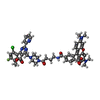+検索条件
-Structure paper
| タイトル | Hepatitis B virus core protein allosteric modulators can distort and disrupt intact capsids. |
|---|---|
| ジャーナル・号・ページ | Elife, Vol. 7, Year 2018 |
| 掲載日 | 2018年1月29日 |
 著者 著者 | Christopher John Schlicksup / Joseph Che-Yen Wang / Samson Francis / Balasubramanian Venkatakrishnan / William W Turner / Michael VanNieuwenhze / Adam Zlotnick /  |
| PubMed 要旨 | Defining mechanisms of direct-acting antivirals facilitates drug development and our understanding of virus function. Heteroaryldihydropyrimidines (HAPs) inappropriately activate assembly of ...Defining mechanisms of direct-acting antivirals facilitates drug development and our understanding of virus function. Heteroaryldihydropyrimidines (HAPs) inappropriately activate assembly of hepatitis B virus (HBV) core protein (Cp), suppressing formation of virions. We examined a fluorophore-labeled HAP, HAP-TAMRA. HAP-TAMRA induced Cp assembly and also bound pre-assembled capsids. Kinetic and spectroscopic studies imply that HAP-binding sites are usually not available but are bound cooperatively. Using cryo-EM, we observed that HAP-TAMRA asymmetrically deformed capsids, creating a heterogeneous array of sharp angles, flat regions, and outright breaks. To achieve high resolution reconstruction (<4 Å), we introduced a disulfide crosslink that rescued particle symmetry. We deduced that HAP-TAMRA caused quasi-sixfold vertices to become flatter and fivefold more angular. This transition led to asymmetric faceting. That a disordered crosslink could rescue symmetry implies that capsids have tensegrity properties. Capsid distortion and disruption is a new mechanism by which molecules like the HAPs can block HBV infection. |
 リンク リンク |  Elife / Elife /  PubMed:29377794 / PubMed:29377794 /  PubMed Central PubMed Central |
| 手法 | EM (単粒子) |
| 解像度 | 4.0 Å |
| 構造データ | |
| 化合物 |  ChemComp-E9D: |
| 由来 |
|
 キーワード キーワード | VIRUS LIKE PARTICLE / capsid / CpAM / antiviral / fluorescent |
 ムービー
ムービー コントローラー
コントローラー 構造ビューア
構造ビューア 万見文献について
万見文献について







 hepatitis b virus genotype d subtype adw (ウイルス)
hepatitis b virus genotype d subtype adw (ウイルス)